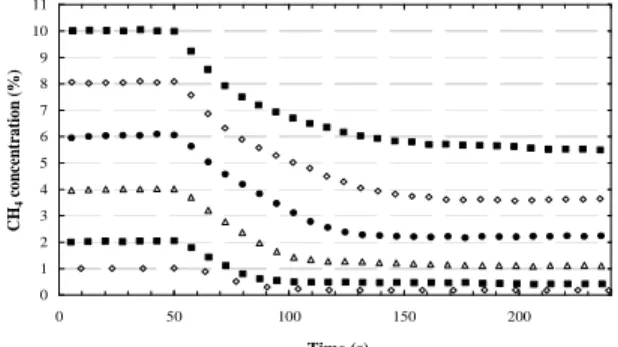HAL Id: hal-00665789
https://hal.archives-ouvertes.fr/hal-00665789
Submitted on 22 Nov 2019
HAL is a multi-disciplinary open access
archive for the deposit and dissemination of
sci-entific research documents, whether they are
pub-lished or not. The documents may come from
teaching and research institutions in France or
abroad, or from public or private research centers.
L’archive ouverte pluridisciplinaire HAL, est
destinée au dépôt et à la diffusion de documents
scientifiques de niveau recherche, publiés ou non,
émanant des établissements d’enseignement et de
recherche français ou étrangers, des laboratoires
publics ou privés.
Gaseous chemistry for a Titan’s atmospheric plasma
experimental simulation
Nathalie Carrasco, Thomas Gautier, Ella Sciamma-O’Brien, Cyril Szopa, Guy
Cernogora, A. Buch, P. Pernot
To cite this version:
Nathalie Carrasco, Thomas Gautier, Ella Sciamma-O’Brien, Cyril Szopa, Guy Cernogora, et al..
Gaseous chemistry for a Titan’s atmospheric plasma experimental simulation. European Planetary
Science Congress 2010, Sep 2010, Rome, Italy. EPSC2010-418 (2p.). �hal-00665789�
Gaseous chemistry for a Titan’s atmospheric plasma
experimental simulation
N. Carrasco (1), T. Gautier (1), E. Sciamma-O’Brien (1), C. Szopa (1), G. Cernogora (1), A.Buch (2) and P. Pernot (3) (1) LATMOS, Université de Versailles Saint Quentin, France, (2) LGPM, Ecole Centrale Paris, France (3) LCP, Université Paris Sud, France (nathalie.carrasco@latmos.ipsl.fr)
Abstract
We present the first study of gaseous composition monitoring for the PAMPRE experiment, which simulates Titan’s atmospheric chemistry by radio-frequency N2-CH4 plasma. Methane consumption is
quantified for various N2-CH4 gas mixtures.
Moreover in situ mass spectrometry (MS) and ex-situ gas chromatography coupled with mass spectrometry (GC-MS) analyses reveal a large dominance of nitrile species in the gas phase chemistry.
1. Introduction
On Titan, the dissociation of N2 and CH4 by solar UV
radiation and Saturn’s magnetosphere electron bombardment induces a complex organic chemistry that results in the production of solid aerosols responsible for the orange haze surrounding Titan. These are the most complex extraterrestrial organic species detected in the solar system. Their chemical production mechanisms, initiated in the gaseous phase, remain mostly unknown and provide a great challenge in astrobiology. Several experimental setups have been developed in order to reproduce and study in the lab such a complex atmospheric system. Among them the plasma device PAMPRE provides recent significant clues on the understanding of the polymeric chemical structure of the aerosols [1], [2]. Here we present a first characterization of the gas phase composition obtained simultaneously with the aerosols formation in the reactive plasma.
2. Experimental Setup
In the PAMPRE experiment [3], different reactive N2-CH4 gas mixtures are studied using a low pressure
(~1 mbar) radiofrequency capacitively coupled plasma discharge. Solid aerosols are formed in suspension in the gas phase, and are collected and weighed at the end of several hours long run. The stable neutrals produced in the gaseous phase are
studied in situ by a Pfeiffer QME 200 quadrupole mass spectrometer. Moreover a cold trap connected to the extraction line of the experiment concentrates the volatile products which are further ex-situ analyzed with gas chromatography coupled with a quadrupole mass spectrometer (ThermoElectron).
3. Results
1.1
Methane consumption
Methane concentration is monitored by in situ mass spectrometry. Initial methane concentrations varying from 1 to 10% of the gaseous mixture lead to steady state concentrations from 0.2 to 5.5% after ~100s of plasma discharge (see Figure 1) [4]. This shows an efficient consumption of methane feeding the formation of organic products both in gas and solid phases. 0 1 2 3 4 5 6 7 8 9 10 11 0 50 100 150 200 Time (s) C H4 c o n ce n tr a ti o n ( % )
Figure 1: Evolution of the CH4 concentration after
plasma ignition (at t=50s) with initial concentrations varying from 1 to 10%.
1.2
Gaseous products
Both in-situ mass spectrometry and ex-situ GC-MS analysis confirm the production of large amount of nitrile species in all the performed experiments, with a large contribution of hydrogen cyanide HCN and
EPSC Abstracts
Vol. 5, EPSC2010-418, 2010
European Planetary Science Congress 2010 c
acetonitrile CH3CN. On the other hand hydrocarbon
products are highly sensitive to the initial methane concentration: almost absent in low methane concentration gas mixtures, they become significant for mixtures with higher contents of methane.
Acknowledgements
We acknowledge the CNRS (PID OPV, PNP), the PRES UniverSud and the French National Research Agency (ANR-09-JCJC-0038) for their financial support. E.S.-O. thanks the PRES UniverSud and the CNES for her postdoctoral fellowships.
References
[1] N. Carrasco, I. Schmitz-Afonso, J-Y. Bonnet, E. Quirico, R. Thissen, O. Dutuit, A. Bagag, O. Laprévote, A. Buch, A. Giulani, Gilles Adandé, F. Ouni, E. Hadamcik, C. Szopa, G. Cernogora: Chemical characterization of tholins: Solubility, Morphology and Molecular Structure revisited. J. Phys. Chem A. 113(42), p.11195, 2009.
[2] P. Pernot, N. Carrasco, R. Thissen and I. Schmitz-Afonso: Tholinomics - Chemical analysis of nitrogen-rich polymers. Analytical Chemistry. 82(4), p.1371, 2010.
[3]. C. Szopa, G. Cernogora, L. Boufendi, J.-J. Correia, P. Coll: PAMPRE: A dusty plasma experiment for Titan's tholins production and study, Planetary and Space Science, 54(4), p.394, 2006.
[4]. E. Sciamma-O'Brien, N. Carrasco, C. Szopa, A. Buch, G. Cernogora: Titan's atmosphere: an optimal gaz mixture for aerosol production ? Icarus. In press, 2010.
